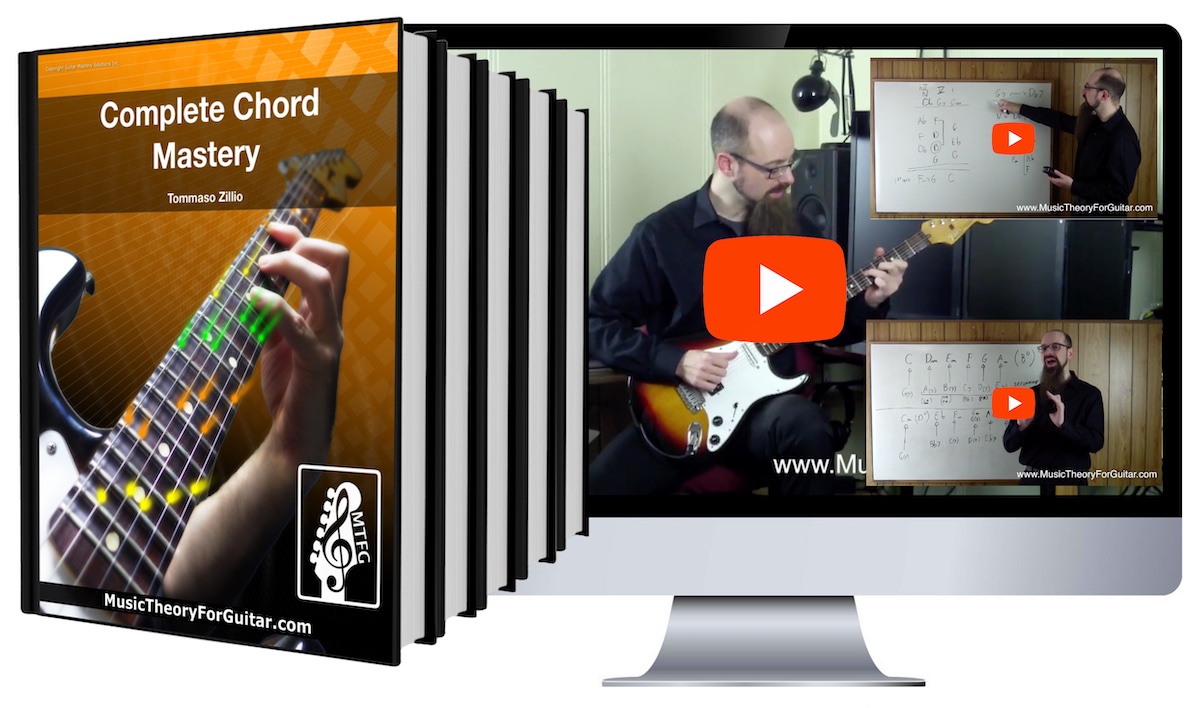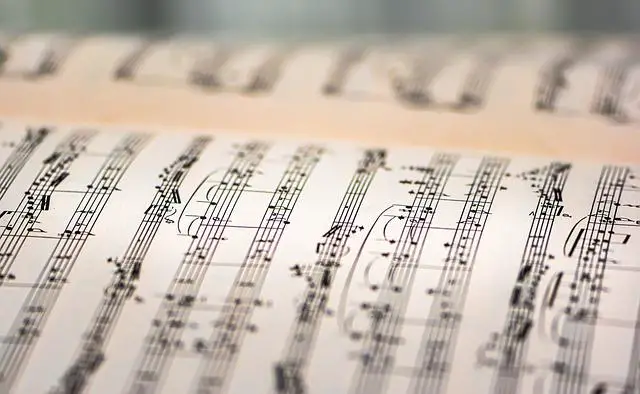So you’ve mastered the art of power chords and can shred like a rock god, but have you ever stopped to wonder why certain notes sound good together and others, well, not so much? Fear not, my fellow axe-wielders, for I am here to guide you on a journey through the mystical world of music theory. Get ready to unlock the secrets of harmony, chord progressions, and scales, and take your guitar skills to a whole new level. Who knows, maybe one day you’ll be serenading the ladies with some sweet jazz chords instead of just playing Wonderwall on repeat. Let’s dive in and unravel the mysteries of music theory together – one epic riff at a time.
Contents
- 1 Understanding the Fundamentals of Music Theory
- 2 Exploring the Building Blocks: Scales and Modes
- 3 The Role of Chords and Progressions in Guitar Mastery
- 4 Rhythm and Timing: The Backbone of Musical Expression
- 5 Incorporating Music Theory into Your Practicing Routine
- 6 Harnessing the Power of Ear Training and Sight Reading
- 7 Advancing Your Guitar Skills Through Creative Application of Music Theory
- 8 FAQs
- 9 Keep Rocking and Rolling!
Understanding the Fundamentals of Music Theory
So you’ve decided to dive into the oh-so-exciting world of music theory, huh? Buckle up, because we’re about to take a wild ride through notes, scales, and chords!
First things first, let’s talk about notes. They’re like the building blocks of music, the alphabet of the musical language. Each note has a name (A, B, C, etc.) and can be either a whole step or a half step away from the next note. It’s like playing a game of musical hopscotch!
Now, onto scales. These bad boys are a series of notes arranged in a specific pattern, kind of like a musical recipe. There are different types of scales, like the major scale, minor scale, and blues scale. Think of scales as the seasoning that adds flavor to your musical dish!
And finally, let’s chat about chords. Chords are like the building blocks of harmony, made up of three or more notes played together. There are different types of chords, like major chords, minor chords, and diminished chords. It’s like creating a musical sandwich - the notes are the fillings, and the chords are the bread that holds it all together!
Exploring the Building Blocks: Scales and Modes
So, you want to dive into the fascinating world of music theory, eh? Well strap in, because we’re about to take a wild ride through the building blocks of music: scales and modes. These little guys are the bread and butter of any musician’s toolkit, so let’s break them down and see what all the fuss is about.
First up, let’s talk about scales. These bad boys are basically just a series of notes that sound good together. Kind of like BFFs, but for your ears. From your basic major and minor scales to more exotic options like the pentatonic or blues scales, there’s a whole smorgasbord of scales to choose from. It’s like choosing your favorite flavor of ice cream, but for music.
Now, onto modes. These guys are like the cool cousins of scales – a little quirky, a little mysterious, but oh-so-cool. Modes are basically different variations of scales that give off different vibes. Want to sound epic? Mixolydian mode. Feeling a bit jazzy? Dorian mode. The possibilities are endless, my friends.
So there you have it, a crash course on scales and modes. They may seem intimidating at first, but trust me, once you get the hang of them, you’ll be composing masterpieces in no time. So go forth, budding musicians, and let the scales and modes guide you on your musical journey!

The Role of Chords and Progressions in Guitar Mastery
When it comes to mastering the guitar, chords and progressions play a crucial role in taking your skills to the next level. It’s like building a house – you can strum a few random notes here and there, but without a solid foundation of chords and progressions, your musical house will come crashing down faster than you can say “D minor.”
Chords are the building blocks of music, and mastering them is essential for any aspiring guitar god or goddess. From the humble E minor to the majestic G7, each chord has its own unique personality and adds a distinct flavor to your musical creations. Think of them as the spices in your musical stew – a pinch of A major here, a dash of C minor there, and voila! You’ve got a tasty musical concoction that will have audiences begging for more.
Progressions, on the other hand, are like the blueprints of a song. They map out the journey from the opening chords to the epic climax, guiding your fingers along the fretboard with precision and finesse. Whether it’s a classic I-IV-V or a more complex jazz progression, mastering these patterns will give you the confidence to riff and improvise like a true guitar virtuoso.
So, grab your guitar, dust off those callused fingertips, and dive headfirst into the wonderful world of chords and progressions. With a little practice, a lot of patience, and a healthy dose of creativity, you’ll soon be wielding your six-stringed weapon with the skill and dexterity of a musical ninja. Rock on, fellow guitar heroes!

Rhythm and Timing: The Backbone of Musical Expression
When it comes to music, rhythm and timing are like the cool kids in school – they make everyone else look good. Without a solid sense of rhythm, music would be like a train without tracks, just chugging along aimlessly. And timing? Well, timing is like the perfect punchline to a joke – it can make or break the whole performance.
Think of rhythm as the heartbeat of a song, keeping everything in sync and providing a steady pulse for musicians to follow. It’s like the metronome that keeps us all on track, making sure we don’t veer off into musical chaos. Because let’s face it, no one wants to listen to a band that sounds like a group of toddlers banging on pots and pans.
And timing? Timing is the secret sauce that adds flavor to a performance. It’s knowing exactly when to come in with that killer guitar solo or when to pause for dramatic effect. It’s what separates the amateurs from the pros, the professionals from the wannabes. So remember, folks, when it comes to music, it’s all about that rhythm and timing.

Incorporating Music Theory into Your Practicing Routine
Are you tired of mindlessly practicing the same scales and chord progressions over and over again? Well, it’s time to spice up your practicing routine by incorporating some music theory into the mix!
First things first, let’s tackle those pesky intervals. Intervals are like the building blocks of music, so it’s essential to understand them. Grab your instrument of choice and start practicing identifying intervals by ear. Trust me, your ear will thank you later!
Next up, let’s talk about chord progressions. Don’t just blindly strum through them, understand why they work the way they do. Dive into the theory behind common chord progressions, like the I-IV-V or the ii-V-I. Once you grasp the theory behind them, you’ll be able to spice up your playing and create some killer progressions of your own.
And finally, don’t forget about modes! Experiment with different modes to give your playing a fresh sound. From the mystical Dorian mode to the exotic Mixolydian mode, there’s a whole world of musical possibilities waiting for you to explore. So grab your instrument, dive in, and let the music theory magic begin!
Harnessing the Power of Ear Training and Sight Reading
So you’ve decided to take your music skills to the next level and delve into the world of ear training and sight reading? Congratulations, you brave soul! While some may shy away from the challenge, you’re ready to harness the power of these two invaluable tools.
With ear training, you’ll be able to identify notes, chords, and melodies just by listening. It’s like having your own superpower, but instead of flying or shooting lasers from your eyes, you can impress your friends with your impeccable pitch and musical prowess.
And sight reading? It’s like reading music notation is suddenly deciphering secret code. No longer will those squiggly lines on the page intimidate you – you’ll be cruising through sheet music like a pro in no time.
So buckle up, strap on your headphones, and get ready to conquer the world of ear training and sight reading. The musical universe is yours for the taking, and with these skills in your arsenal, there’s no limit to what you can achieve. Time to show the world that you’re not just another musician – you’re a musical wizard!
Advancing Your Guitar Skills Through Creative Application of Music Theory
So you’ve mastered the basic chords and can strum a sweet tune on your guitar. But why stop there? By applying some music theory in a creative way, you can take your guitar skills to the next level and impress all your friends at the next jam session.
One way to spice up your playing is by experimenting with different chord progressions. Instead of sticking to the same old G-C-D pattern, try mixing it up with some unexpected chords. Maybe throw in a Bb or an F#m for a surprising twist. The key is to keep it interesting and keep your audience on their toes.
Another fun technique to try is incorporating modes into your playing. Mix it up with some Dorian or Phrygian scales for a jazzy or exotic sound. Don’t be afraid to experiment and see what sounds best to your ear. Who knows, you might discover a whole new style of playing that sets you apart from the rest.
And lastly, don’t forget to use dynamics to your advantage. Play around with volume, tempo, and even silence to create tension and release in your music. A well-placed pause or a sudden crescendo can add drama and excitement to your playing. So go forth, brave guitarist, and let your creativity and music theory knowledge guide you to new heights of guitar greatness!
FAQs
What is music theory and why is it important for guitar players?
Music theory is like the secret code to unlocking the mysteries of music. It helps guitar players understand how music works, including chords, scales, and harmony. It’s like having a cheat sheet for rocking out on your guitar.
How can music theory improve my guitar playing skills?
Think of music theory as your trusty sidekick in the world of guitar playing. It can help you understand why certain chords sound good together, how to create killer solos, and even how to write your own songs. Plus, it’s the key to impressing your fellow musicians with your mad skills.
Do I really need to learn music theory to be a good guitar player?
Well, technically no, you don’t need to know music theory to strum a few chords or play some catchy riffs. But if you want to take your guitar playing to the next level, impress your friends, or even pursue a career in music, then learning music theory is like adding rocket fuel to your guitar skills.
Are there any easy ways to start learning music theory for guitar?
Luckily, there are tons of resources out there to help you dip your toes into the magical world of music theory. You can find online tutorials, books, classes, or even hire a music teacher to guide you through the basics. And hey, who knows, you might just discover a new passion for music theory along the way.
Can music theory help me write my own songs on the guitar?
Absolutely! With music theory in your back pocket, you’ll have the knowledge and tools to create your own unique sounds, experiment with different chord progressions, and craft catchy melodies. Who knows, you might just write the next chart-topping hit on your trusty guitar.
Keep Rocking and Rolling!
So there you have it, budding guitar gods and goddesses! Don’t be afraid to dive into the world of music theory to take your skills to new heights. Whether you’re shredding like a pro or strumming your heart out, understanding the theory behind the music will only make you a better player. So keep practicing, keep learning, and most importantly, keep rocking and rolling! Who knows, maybe one day you’ll be the next guitar legend!
Now go forth and serenade the world with your newfound knowledge. And remember, as they say, practice makes perfect – but a little music theory couldn’t hurt either!



